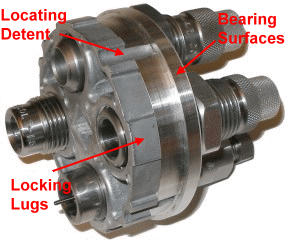
The old adage, “The devil is in the details” implies an accurate assessment of something large in scale can only be made by examining it’s smallest parts. This concept clearly applies when selecting handloading equipment. Frequently, products are recommended based upon: company reputation, production capacity and service department support. Unfortunately, while these are important factors, omitted from the assessment are the basics: quality of design, quality of materials and quality of assembly; the things that will make a difference in ease of use and product longevity.
Some very popular cast iron turret presses are beefy by weight but weak through design. In center mount turret designs, loads are exerted farthest from the central mounting bolt where there is a lot of leveraged force applied to the turret edge. Consequently, deflection of the outside of the turret will result in proportional angular misalignment of die to cartridge centerlines. Yes I am aware there is typically a cast boss and indexing ball positioned under the turret opposite the active die position, however, operating clearances required for the turret to rotate freely and for the spring loaded indexing ball to function means the edge of a turret head will rock with even modest finger pressure. A dial indicator set up on my RCBS press, for example, indicated .006″ movement when modest finger pressure was applied.
The Lee turret is quite different in design from the type of press noted above. The load bearing surfaces, rotational or lateral contact, are at the circumference of the turret providing full and uniform support. As a result, dies are kept on centerline with cartridge cases and pressure is always in alignment with the cartridge components. The Lee turret is made from an A360 alloy of aluminum casting which has a tinsel strength of 46,000 PSI, compared to 28,000 to 30,000 PSI for cast iron. The Lee Turret, smaller than the large cast iron heads, is appropriately sized to handle a full set of pistol dies, including a factory crimp die, and still accomplish powder/priming chores. The use of light alloy also means improved corrosion resistance and light weight which makes indexing more positive and reduces wear and tear on equipment and operator.
Adding to the Basic System
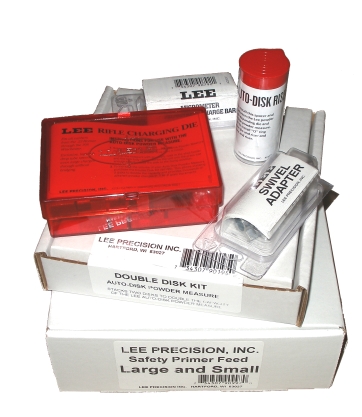 When I first thumbed through the Lee equipment catalogue I noticed many small pieces and special kits which caused me to wondered why the material wasn’t just included with the major equipment pieces. It didn’t take long to realize, many of these small assemblies have a very specific application, so why unnecessarily burden the basic equipment prices with items that may not be required?
When I first thumbed through the Lee equipment catalogue I noticed many small pieces and special kits which caused me to wondered why the material wasn’t just included with the major equipment pieces. It didn’t take long to realize, many of these small assemblies have a very specific application, so why unnecessarily burden the basic equipment prices with items that may not be required?
Someone could very easily purchase an Anniversary or Deluxe Turret Kit and never need much more than what came inside the box. On the other hand, I could see someone who has to put together lots of equipment from lots of sources and needs a few pieces to make things work together correctly. I found some optional material to be a refinement or enhancement of the basic product, others addressed some unique circumstances and still others able to expand overall system capabilities and performance. None of them were items that would be tried then retired to a storage cabinet.
Lee LPS & Safety Prime Systems
 At the time of this writing the Lee Lever Primer System, or “LPS”, is incorporated into the: Classic Turret Press, 4 Hole Turret Press and the Classic Cast Press. LPS is the basic priming system for these products and is included in large and small primer versions. In operation, it is a very simple and reliable system. A primer lever (pictured right) is inserted into the slot in the press ram (below, sequence left to right), a shell holder is slipped into place, as the ram is raised the primer lever tips forward to receive a primer, a primer is inserted, the ram is lowered causing the primer lever to tip inward. As the ram bottoms, a primer is lifted through the center of the shell holder and into a waiting cartridge case.
At the time of this writing the Lee Lever Primer System, or “LPS”, is incorporated into the: Classic Turret Press, 4 Hole Turret Press and the Classic Cast Press. LPS is the basic priming system for these products and is included in large and small primer versions. In operation, it is a very simple and reliable system. A primer lever (pictured right) is inserted into the slot in the press ram (below, sequence left to right), a shell holder is slipped into place, as the ram is raised the primer lever tips forward to receive a primer, a primer is inserted, the ram is lowered causing the primer lever to tip inward. As the ram bottoms, a primer is lifted through the center of the shell holder and into a waiting cartridge case.

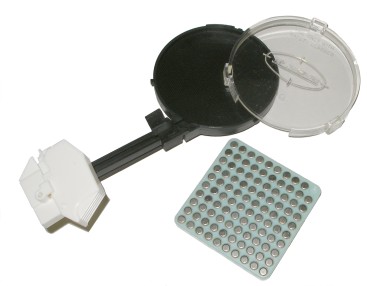 The primary draw back of the basic LPS system is the manual pick and place of primers and the opportunity for contamination through handling; AKA BBQ sauce in the priming compound. Compared to competing systems, the LPS is probably the least jam prone while similar in number of manual steps. The Safety Prime system eliminates handling contamination and speeds priming.
The primary draw back of the basic LPS system is the manual pick and place of primers and the opportunity for contamination through handling; AKA BBQ sauce in the priming compound. Compared to competing systems, the LPS is probably the least jam prone while similar in number of manual steps. The Safety Prime system eliminates handling contamination and speeds priming.
Essentially, the operator’s index finger and thumb, and box full of primers, are replaced with a self righting primer tray that holds 100 primers, a feed track and a “trigger” that inserts primers into the primer cup on the LPS primer arm. No more human – primer contact.
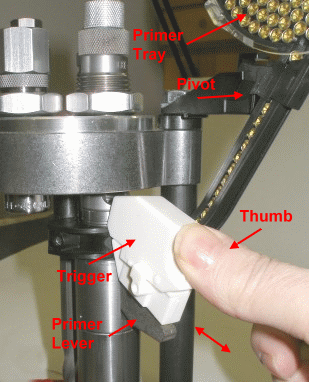 Pictured right is the Safety Prime unit mounted on the Classic Turret. The primer tray and feed track, as well as the white trigger assembly pivot within the bracket that is mounted to the press. Pushing on the white trigger swings it into contact with the ram mounted primer arm and deposits a fresh primer into the arm’s primer cup. It is a simple and fast process and if you understand a PEZ dispenser you will understand the concept….just don’t bite into the “candy”. There are two versions of the Safety Prime, large primer (white trigger) and small (black trigger). The units are self contained, change-out only requires lifting one unit off and replacing with the other.
Pictured right is the Safety Prime unit mounted on the Classic Turret. The primer tray and feed track, as well as the white trigger assembly pivot within the bracket that is mounted to the press. Pushing on the white trigger swings it into contact with the ram mounted primer arm and deposits a fresh primer into the arm’s primer cup. It is a simple and fast process and if you understand a PEZ dispenser you will understand the concept….just don’t bite into the “candy”. There are two versions of the Safety Prime, large primer (white trigger) and small (black trigger). The units are self contained, change-out only requires lifting one unit off and replacing with the other.
The 100 primer capacity is, of course, a match for the number of primers in a conventional package. The floor of the tray is ribbed, so shaking it side to side will roll the little suckers over until they are all right side up for feeding into the track. Again, no physical contact is required to load or dispense the primers. Additional primer trays are available as spare parts directly from Lee Precision at $5 each, a minor investment for the convenience of having frequently used primer types loaded up and ready to drop onto the press. No, I did not use a stunt thumb.

I prefer this Lee system to the RCBS shuttle priming system because the primers are located above the turret where it is clean rather than low in the base like the RCBS system where fresh primers can be exposed to heavy powder and primer residue. The Lee press ejects spent primers downward through the center of the press ram and into a waiting clear plastic tube. The RCBS ejects primers from the side of the ram and it gets messy. For primer loading, it is far easier to dump a box of primers into the Lee Primer Tray then to pick them up one at a time with the RCBS primer tube.
When mounted on the Deluxe or Classic Turret presses along with an Auto-Disk Powder Measure, an Auto-Disk Riser should be used to raise the powder measure to clear the primer tray. The riser will also provides clearance for tall and unwieldy die sets that may have wander onto the press from another manufacturer. The Safety Prime is available in small and large primer version at $20 each, or a combo for $30 directly from Lee Precision, or $13 and $20 respectively through most online discount retailers.
The Lee Auto-Disk Powder Measure System
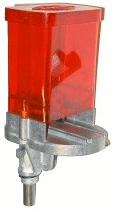 The Auto-Disk system was a pleasant surprise. If you have been disappointed with Culver type measures, and have given up on mechanical metering of charges for precise handloads, there may still be hope. I found the performance of this set up to be exceptional. I threw a total of 150 charges, 50 charges of ball powder Accurate No. 7, 50 charges of spherical Hodgdon H110, 50 charges of short extruded Hodgdon Varget. I scale verified every charge and the worst case variation was two tenths of a grain from extreme high to extreme low with the micrometer adjustable charge bar in place. The basic Auto-Disk measure is a $20 item when purchased through online discount retailers. I need to spend more time with this system, but, preliminarily it did outperform, by a wide margin a: $60 Hornady Lock-N-Load, $60 RCBS Uniflow and a $230 Harrell Premium measure. It may be the shuttling fill and feed motion as of the Auto-Disk compared to the rotating cavity metering of the Culver type measures that made for more uniform metering but, whatever the reason, the design works. The Auto-Disk Powder Measure is compact and light weight at less than 12 oz. Still, it holds approximately 6.5 oz of powder, which is about 2850 grains of powder, or approximately 123 or 124 hellacious H110 handloads for the 45 Colt. Neat.
The Auto-Disk system was a pleasant surprise. If you have been disappointed with Culver type measures, and have given up on mechanical metering of charges for precise handloads, there may still be hope. I found the performance of this set up to be exceptional. I threw a total of 150 charges, 50 charges of ball powder Accurate No. 7, 50 charges of spherical Hodgdon H110, 50 charges of short extruded Hodgdon Varget. I scale verified every charge and the worst case variation was two tenths of a grain from extreme high to extreme low with the micrometer adjustable charge bar in place. The basic Auto-Disk measure is a $20 item when purchased through online discount retailers. I need to spend more time with this system, but, preliminarily it did outperform, by a wide margin a: $60 Hornady Lock-N-Load, $60 RCBS Uniflow and a $230 Harrell Premium measure. It may be the shuttling fill and feed motion as of the Auto-Disk compared to the rotating cavity metering of the Culver type measures that made for more uniform metering but, whatever the reason, the design works. The Auto-Disk Powder Measure is compact and light weight at less than 12 oz. Still, it holds approximately 6.5 oz of powder, which is about 2850 grains of powder, or approximately 123 or 124 hellacious H110 handloads for the 45 Colt. Neat.
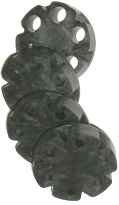
The “Disk” in the product’s name refers to the glass filled polymer disks used to meter powder. Standard Lee Auto-Disk Powder Measures are supplied with 4 disks, each with a series of 6 different size holes. With assistance from a data table supplied with the measure, it is possible to match a hole size with a powder type and come close to a predetermined powder charge. Instructions recommend that charges be kept to at least 10% below maximum to allow for powder variations and exercise extra caution when loading flake powder. The standard Auto-Disk measure holds any single disk in the set. In operation, the powder flows from the hopper into the cavity in the disk below. When the measure is actuated, the disk moves from under the hopper where it is filled, to over the drop tube where it empties into a waiting cartridge case. A Double Disk Kit allows two disks to be stacked one on top of the other, smallest cavity on top, for increased capacity and more combinations for greater charge size selection. Selling for $15, the kit includes 4 charge disks as well as plastic standoffs and longer mount screws to raise the hopper high enough to clear the double disk stack.
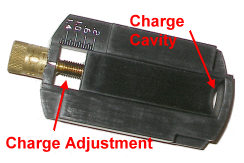
In single disk configuration, the Micrometer Adjustable Charge Bar can replace the charge disk and meter powder. This unit was in place when I threw those very consistent charges mentioned earlier. The unit is scaled in cubic centimeters and packaged with conversion instructions to calibrate to a specific powder type. Being the lazy guy I am, I mostly played with incremental adjustment until the unit was throwing the charge weight I wanted. I had very good results with ball, spherical and short extruded. I intend to complete checking out the unit with flake powder and run the extremes in charge sizes. It’s a nice set up that runs about $10.
Volume Measure Density
All of the metering devices included with Auto-Disk powder measures are scaled in cubic centimeters. This is different from most other brands where incremental measurement is stated in grains. Again, design worth examining. A grain is a unit of weight, not volume, and a grain of different types of powder will occupy different volumes. That means when you spin that measure’s thimble around you are essentially making a relative adjustment and, for the most part, the little numbers next to the index marks on the measure are for show. For as much as I like their aesthetics, the most pretentious measures are the Harrell products with double dip chrome and brass micrometer adjustments and the same old Culver apparatus below the surface. The inexpensive but hyper accurate Lee measures are different in a number of ways beyond the shuttle like metering. All Auto Disk metering components are identified by cc volume. So if you see a .43 indication stamped next to a disk cavity, that hole has a volume of .43 centimeters. Next, Lee publishes a Volume Measure Density table that converts a grain of a specific type powder into a cc equivalency. In doing so, they account for variations in powder type density and all measurement and increments are stated as volume, the only way to measure in the absence of a scale. Setting the equipment is easier to do than to explain, but as an example –
-
AA No. 7 has a VMD of .0653 (one grain has a volume of .0653 cc)
-
A 12 grain charge of No. 7 requires a .784 cc cavity (12x .0653)
-
Selecting a .76 charge disk cavity, I can get to 11.6 grains (.760/.0653)
Alternatively, I could go to my two disk set and use in combination a .30 and .49 cavities for .79 or 12.1 grains. Lee Precision indicated 10% below maximum, so all are well within range and charge to charge consistency is probably of greater importance. Of course, I could also insert a Micro Charge Bar and set it exactly to what is required to throw a 12 grain charge. The point is, if you are a “read the instructions and use the equipment as intended” kind of guy, with the VMD measurement system you will have a better shot at accurate settings. If you are the kind of guy who jumps in and flogs until something happens, you probably haven’t read this far anyway.
A Few Last Odds and Ends
 The swivel adapter replaces the standard Auto-Disk actuator and allows the powder measure to remain stationary while a thumbwheel is turned to move the measure on or off the press. With the swivel installed, the measure can also be rotated and locked down in position to the operator’s preference. This is a $6 part and can be purchased directly from Lee Precision. The Auto-Disk Riser is an extension that screws into a pistol expander die r which is hollow bodied to allow powder to pass through. The expander die also actuates the powder measure when the ram is raised to the top of its stroke. The riser is necessary for tray clearance when the Lee Safety Prime system is installed, and also where tall dies are in place that might interfere with the positioning of the powder measure. The riser is a $10 part.
The swivel adapter replaces the standard Auto-Disk actuator and allows the powder measure to remain stationary while a thumbwheel is turned to move the measure on or off the press. With the swivel installed, the measure can also be rotated and locked down in position to the operator’s preference. This is a $6 part and can be purchased directly from Lee Precision. The Auto-Disk Riser is an extension that screws into a pistol expander die r which is hollow bodied to allow powder to pass through. The expander die also actuates the powder measure when the ram is raised to the top of its stroke. The riser is necessary for tray clearance when the Lee Safety Prime system is installed, and also where tall dies are in place that might interfere with the positioning of the powder measure. The riser is a $10 part.
Bottleneck rifle die sets do not typically have an expander die so the Auto-Disk Powder Measure is mounted to the turret in conjunction with the Rifle Charging Die. This is another powder through die with no other function than to support the Auto-Disk Powder Measure. The Riser can be used in concert with the Rifle Charging die to gain even more clearance where necessary.
Last But Not Least
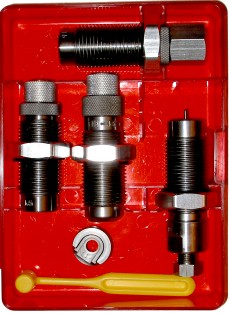
Probably not accessories, but clearly useful items, Lee Precision has quite the combination of dies sets. A Lee RGB (Really Good Buy) rifle set runs $10 though discount retailers. A Pacesetter rifle set; sizer, seater and factory crimp die goes for $20. Lee Steel sets for classic straight cartridges like the 38-40 WCF are $20 and include sizer, powder through expander and seater dies. 2 piece collet die sets for rifles are approx. $23.
My personal preference are the Deluxe rifle and pistol sets because a few bucks more, and still well under competitor’s prices these are very complete sets. The rifle sets some with a neck sizing collet die, a conventional full length sizer and a bullet seating die. a shell holder, powder measure and load data is packed in every box. Tough deal to beat at $26. The Deluxe pistol sets contain a sizer, expander, seater and factory crimp die, along with a shell holder, measure and load data.
Huge dies, 1/1/4″ threads for cartridges like the 50 BMG, run $100 a set. Custom die sets are available for under $200, including set up cost, and custom seating plugs are $8
Lee Precision – Organization and Support
It is nice to find people who obviously like what they sell and have detailed product knowledge of all. I’m not knocking other good companies, but try to have a chat with someone answering tech phones at Marlin about anything technical and you’ll learn the meaning of the words “proprietary information” and what it is like to squeeze testimony out of a Mafia don. I’m still waiting for an email response from Barnes that I sent two years ago and even retailers like MidwayUSA aren’t all that exciting when it comes to having a product support related dialogue. What I found at Lee Precision are people who are accessible and actually enjoy talking about their products, including an explanation of the rational behind product design. I trust that, I trust people who can get caught up in the detail of their own creations.
I try to be as accurate as possible when I write. Yes, except of course in the areas of grammar and punctuation. If I had a question or wanted to verify an understanding of operation, I was able to get help. John Lee took the time to explain the thinking behind the selection of aluminum for turret material and why the fully supported turret design was conducive to making exceptional ammo. I also now know why yellow zinc dichromate plating was selected for the Classic press linkage parts; high rust resistance, more durable surface than black oxide and it looks good. And the Classic Turret is a good looking piece of equipment. Pat in tech support seems to know every piece part and assembly that is packaged with various press models in kits, so what might have been a 2 day research exploration for information at another company was a 5 minute phone call to Lee Precision Support. Nice people and good products.
At the moment I have to wear sun glasses when I work to tone down all of that bright red paint, gold color plating and polished steel and aluminum surfaces. Still, I anticipate I will stop playing with the equipment and get down to some serious functional and longer term assessment for the next and last installment.
For more related information:
Lee Classic Turret Press Part I – Lee Equipment – It’s not just for Kids
Lee Classic Turret Press Part II – Form Follows Function – A closer Look
Lee Classic Turret Press Part III – It’s Pretty, But Does it Make Good Ammo?
Thanks,
Joe

Email Notification